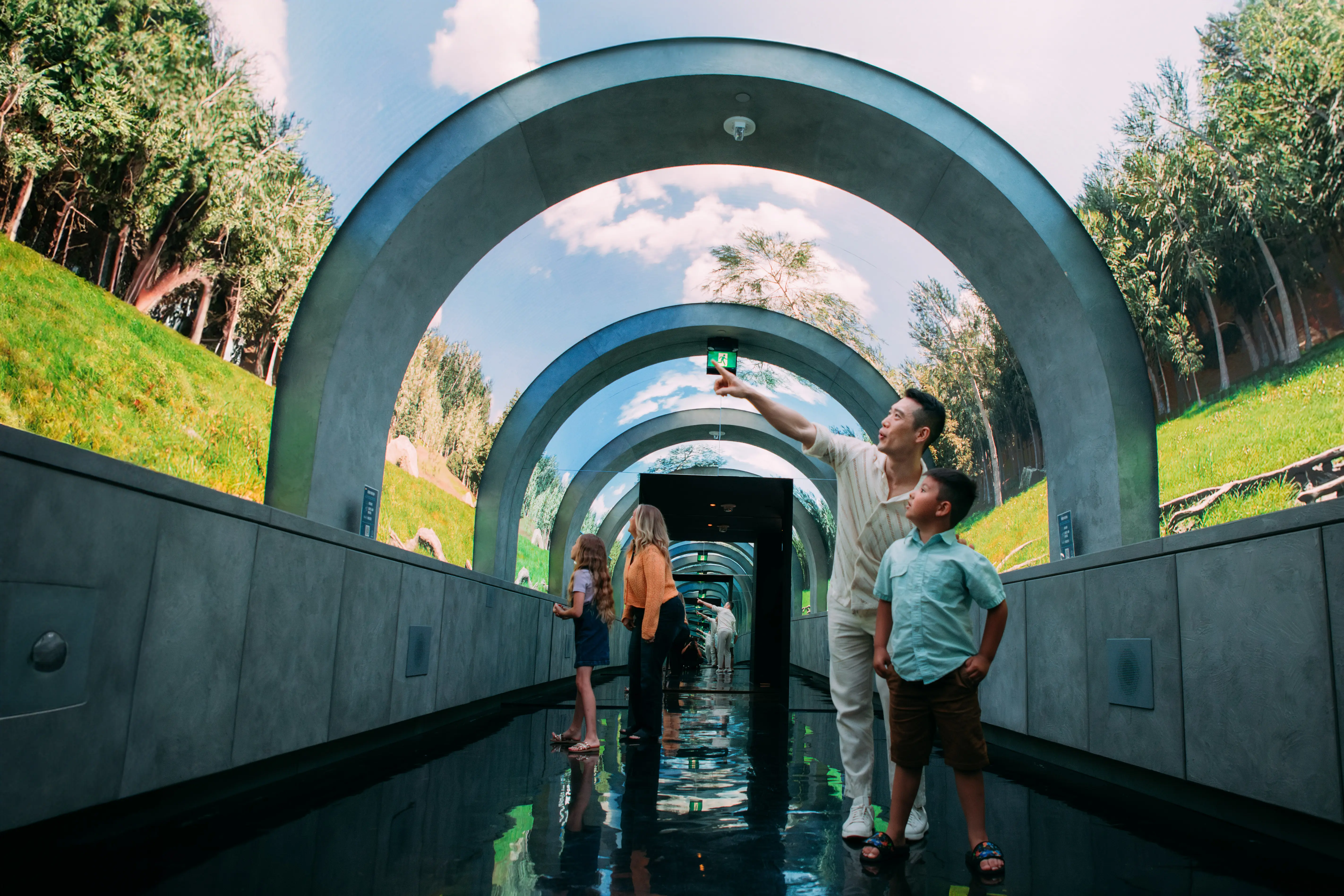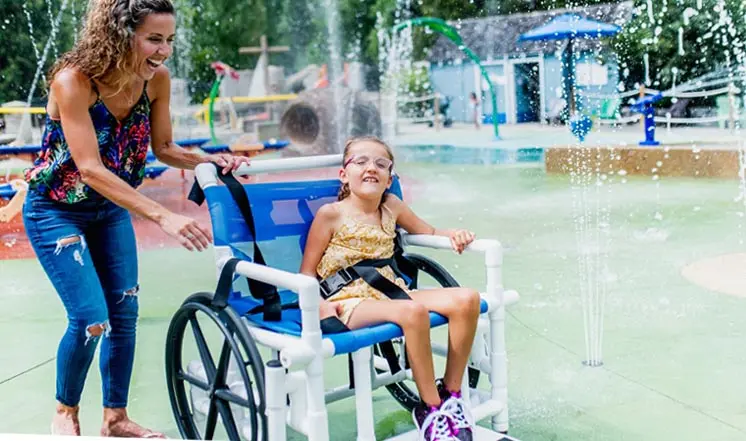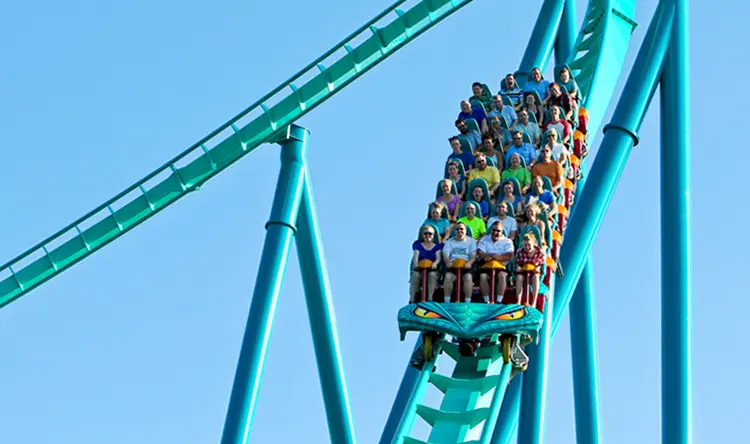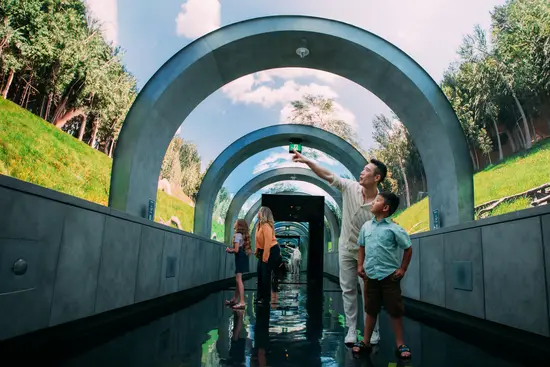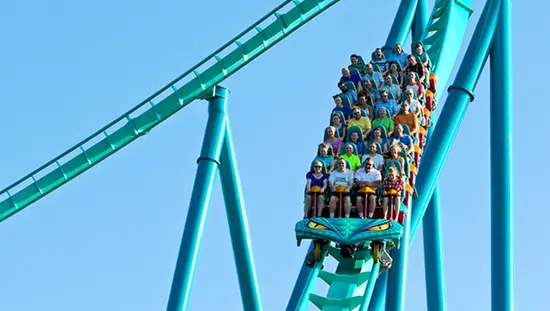Canada’s Wonderland
Canada’s Wonderland is the very definition of ultimate summer family fun.
Spanning over 130 hectares and featuring over 200 attractions Canada’s Wonderland is Canada’s largest theme park. Epic rollercoaster rides, a large water park with a lazy river, all your favourite food options, exciting live shows and themed entertainment areas have given it the distinction of being one of North America’s most popular theme parks.
Vaughan | Canada’s Wonderland
How to get to Canada’s Wonderland
Location: 1 Canada’s Wonderland Drive, Vaughan
By car: The park is approximately 50 kilometres north of downtown Toronto at the Rutherford Road exit off Highway 400. Paid parking is available, with the option to pay online in advance.
By transit: GO Transit, TTC and YRT offer regular service between Toronto and Vaughan.
Know before you go
Canada’s Wonderland operates from early May to early September. It usually remains open on weekends only through October.
Get tickets for single-day admission or a season pass for unlimited daytime visits, plus discounts on food and merch.
Only cashless payments are accepted. Visit the Cash-to-Card kiosks to convert your cash into a prepaid debit card.
Strollers and wheelchairs are available for one-day rental on a first-come, first-served basis.
Things to do at Canada’s Wonderland
Discover more activities and experiences.
Experience rollercoaster thrills
Get your adrenaline racing in the Action Zone, home to several of the park’s most exhilarating rides. Swing through the air on the WindSeeker or dare to ride the Behemoth rollercoaster.
Walk on International Street
Browse shops, restaurants and candy stores on International Street. It’s also home to Wonder Mountain’s Guardian, a unique, interactive ride using 3D and 4D technology.
Enjoy special events
Sample new flavours at food festivals and catch kid-friendly shows and performances. Discover a full lineup of events and download the mobile app for a complete list of shows.
Keep young kids entertained
Watch your kids slide, climb and run in the Maple Park Treehouse. The KidZville and Planet Snoopy are two zones with rides and attractions designed for the youngest guests.
Chill at the waterpark
Cool down at Splash Works, an eight-hectare water park with 17 different attractions including cliff jumping, water slides, a wave pool and lazy river.
Find your favourite foods
Fuel up with a meal or snack, such as a classic Canadian treat from Après Poutinerie and Beavertails or a gourmet lunch at the Lazy Bear Lodge or Timbers Grill.
Articles and itineraries
Get ideas and inspiration for your next trip.

Interesting facts about Canada’s Wonderland
Canada’s Wonderland opened in 1981 with a spectacular ceremony featuring 10,000 helium balloons, 350 white doves, 13 parachutists and a pipe band.
Since then, the park has continued to grow and modernize. The 18-metre-tall Victoria Falls acts as a cooling tower for the park’s air conditioning. As the water cascades off the mountain, it’s cooled and distributed to various buildings through an underground utility system.
Canada’s Wonderland is home to the record-breaking Yukon Striker. With a maximum speed of 130 kilometres per hour, it’s the fastest, longest and tallest dive coaster in the world.
Accessibility features
Ramps
An inclined plane that allows wheelchair users and others to access buildings and navigate between different levels.
Wide doorways and hallways
A sufficiently wide, hard-surfaced, unobstructed path to allow for easy travel.
Automatic doors
Main entrance doors and other accessible entrances and exits are power assisted to allow easy access.
Elevator access
Elevators should be designed to be usable independently by and accessible to persons using wheelchairs, scooters, walkers, canes or crutches, to enter and exit all public facilities. Controls/buttons should include tactile information to ensure easy use by persons who have visual limitations. Controls/buttons should be easy to reach and push, be raised and require minimal strength to activate.
Sensory-friendly areas
Crafted to minimize overwhelming sensory input. This includes features like dimmed lighting, noise-cancelling options and calming textures.
Accessible restaurant
Designed to be accessible to persons with varying disabilities, including those using mobility aids. They include an accessible entrance, adequate maneuvering space, nearby accessible washrooms, tables with removable chairs and sufficient knee clearance, menus in alternate formats, and cafeteria or buffet counters that are reachable for mobility device users.
Accessible seating
For persons using mobility aids, accessible seating is available in all areas or levels for persons using mobility aids. The path to the accessible seating should be barrier-free so a person using a mobility device can access it. Reserved space with a clear view of the event/activity for someone who is seated, good sound quality and adequate maneuvering room for a mobility device.
Easy access electrical outlets
At least one electrical outlet is within easy reach and has clear floor space in front for charging an electric mobility device.
Accessible outdoor eating area
Places located outside where members of the public can sit at a table and eat (for example, outdoor food courts at amusement parks or picnic tables in parks). This includes accessible tables with enough clear space around and under so that people using a wheelchair or other mobility aid can easily access. Also, the ground leading to and under the accessible tables is level, firm and stable.
Information available in alternative format
Alternative formats present information beyond standard text, such as electronic text, audio, captioning and Braille. Accessible formats are available for menus, brochures, maps, signage or websites. Communication support must be provided in a timely manner upon request, at no extra charge, in consultation with the person making the request.
Wheelchair and/or mobility devices available
Mobility devices such as wheelchairs, walkers, canes or mobility scooters are available for people to borrow or rent at the business. If you make wheelchairs or assistive devices available to the public, it is important to make sure that they are properly maintained and periodically serviced so they are in good working order and do not present a safety risk.
Support persons welcome
By law, you must allow a person with a disability to be accompanied by his or her support person while in the areas of your business that are open to the public. A support person is an individual hired or chosen by a person with a disability to provide services or assistance with communication, mobility, personal care, medical needs or with accessing goods, services or facilities. If you charge an admission fee at your business, you must let people know you charge an additional fee for a support person.
Service animals welcome
Can be identified by visual indicators (such as a vest or harness) or documentation from a regulated health professional confirming the animal is necessary due to a disability. In Ontario, service animals are allowed in all public spaces unless otherwise prohibited by law. A service animal is not a pet; it is trained to perform tasks to assist a person with a disability, such as guiding individuals with vision impairments, alerting to sounds for those with hearing impairments, assisting during seizures, retrieving items, or helping manage psychiatric and neurological disabilities. There are no restrictions on the type of animal used as a service animal in Ontario. If the animal is not easily identifiable, the person can provide documentation from a regulated health professional confirming the need for the service animal.
Assistive listening devices available
Assistive listening devices are available for rent or free of charge. You can select this feature if you offer assistive listening devices to help people with hearing loss better hear a performance or event. These devices can include frequency modulation (FM) systems, infrared systems and audio induction loop systems. It is important to check the devices periodically to ensure that they are in good working order (i.e., working batteries and not in need of maintenance).
Accessible parking space
Accessible parking provides a place for people with disabilities to park and space to get in and out of their vehicles safely. It also provides access to the main accessible entrance and/or any other accessible entrances. Most users of wheelchairs need at least three feet of clearance to get in and out of their vehicles.
Accessible drop off location
A designated and signed area used for loading and unloading passengers into or out of a waiting vehicle. A passenger drop-off/pick-up area typically should include a driveway, a lay-by for the stopped vehicle close to an accessible entrance and an accessible route from the drop-off/pick-up area to the main entrance. It is important that any drop-off locations are clear of snow and ice or other obstructions.
Accessible bus/Shuttle services serve site
Accessible transportation is available to help you reach your destination. These may include accessible public buses, taxis or shuttles.
Accessible washroom
At least one washroom stall larger than the others to accommodate adequate maneuvering space for mobility devices. They also include grab bars, transfer space, an accessible door latch, sink with knee clearance, and lever handles or automatic sensor faucets.
Evacuation chairs
Compact and foldable mobile chairs used to evacuate people with disabilities down the stairs. Evacuation chairs may be manually operated or have a battery-powered motor.
Accessible pool
A pool designed to be inclusive and usable for people with disabilities. Large pools must have at least two accessible entry/exit points, while small pools require one. Accessible features include a lift (fixed or portable) that can be independently operated by someone with a disability and powered by battery or water pressure. Sloped entries are also required to ensure easy access. All accessibility features must be well-maintained and fully functional during pool hours.
Last updated: September 2, 2025




